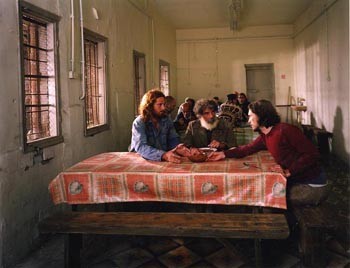Adi Nes
26 Jan - 08 Mar 2008
ADI NES
Adi Nes, who lives and works in Tel Aviv is offering ous an interesting answer to question of the role of the artist in country in a conflict situation. Even if context isn’t the unique topic of his work, one can’t ignore that the different series take place consecutivley in the army, the street or in prison.
Adi Nes’s works immediatly show a shrewd and meticulous stage-work, based on direct references to well-known works in art history. What is essentilly involved is an iconographic and theoretical re-interpretation of original subjects, which are transposed into a contemporary setting and envirronement. But Nes’s eye focuses especially on pictorial typologies. Rather than refering to any specific work, the artist’s work tends to highlight general features and methods of spatial organization in painting.
What is distinctive about Adi Nes is the intelligence he applies in juxtaposing the intensity of the film image with classical compositions drawn from the history of painting, in photographs which offer us his critic view on our age.
For his exhibition at Praz-Delavallade Adi Nes is showing his new series « Biblical Strories ». All the photographs of the series are based on figures of the Old-Testament. The heroes of Nes’ new series are street people, the homeless, marginalized individuals in a live miserable lives without purpose or a future. Noah is drunk and naked, rolled-up beside a DVD rental machine; Jonathan is a battered boy in David’s arms, Hagar is a beggar on a street corner.
The photographed scenes are completely fictional; everything is briliantly preconceived, staged, choreographed around actors to which he not rarely asks to replay the scene repeatedly. The series also reveals the growing social heterogeneity in Israeli society, which appeared due to the revolution it has undergone from a utopian, caring society full of ideals and equality to a capitalistic, alienating society with large social gaps. Nes juxtaposes identity-less homeless people and Bible stories with the harsh realities of present-day Israel and the myth of the Chosen People. He projects this troubling picture of modern Israeli society two thousand years into the nation’s past. In exposing the eternal in the everyday, he shows how the current Israeli situation demolishes past national glories.
Adi Nes, who lives and works in Tel Aviv is offering ous an interesting answer to question of the role of the artist in country in a conflict situation. Even if context isn’t the unique topic of his work, one can’t ignore that the different series take place consecutivley in the army, the street or in prison.
Adi Nes’s works immediatly show a shrewd and meticulous stage-work, based on direct references to well-known works in art history. What is essentilly involved is an iconographic and theoretical re-interpretation of original subjects, which are transposed into a contemporary setting and envirronement. But Nes’s eye focuses especially on pictorial typologies. Rather than refering to any specific work, the artist’s work tends to highlight general features and methods of spatial organization in painting.
What is distinctive about Adi Nes is the intelligence he applies in juxtaposing the intensity of the film image with classical compositions drawn from the history of painting, in photographs which offer us his critic view on our age.
For his exhibition at Praz-Delavallade Adi Nes is showing his new series « Biblical Strories ». All the photographs of the series are based on figures of the Old-Testament. The heroes of Nes’ new series are street people, the homeless, marginalized individuals in a live miserable lives without purpose or a future. Noah is drunk and naked, rolled-up beside a DVD rental machine; Jonathan is a battered boy in David’s arms, Hagar is a beggar on a street corner.
The photographed scenes are completely fictional; everything is briliantly preconceived, staged, choreographed around actors to which he not rarely asks to replay the scene repeatedly. The series also reveals the growing social heterogeneity in Israeli society, which appeared due to the revolution it has undergone from a utopian, caring society full of ideals and equality to a capitalistic, alienating society with large social gaps. Nes juxtaposes identity-less homeless people and Bible stories with the harsh realities of present-day Israel and the myth of the Chosen People. He projects this troubling picture of modern Israeli society two thousand years into the nation’s past. In exposing the eternal in the everyday, he shows how the current Israeli situation demolishes past national glories.

